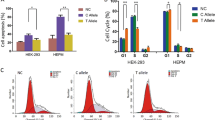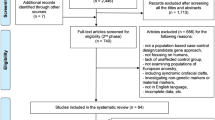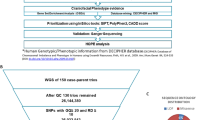Abstract
We conducted a genome-wide association study involving 224 cases and 383 controls of Central European origin to identify susceptibility loci for nonsyndromic cleft lip with or without cleft palate (NSCL/P). A 640-kb region at chromosome 8q24.21 was found to contain multiple markers with highly significant evidence for association with the cleft phenotype, including three markers that reached genome-wide significance. The 640-kb cleft-associated region was saturated with 146 SNP markers and then analyzed in our entire NSCL/P sample of 462 unrelated cases and 954 controls. In the entire sample, the most significant SNP (rs987525) had a P value of 3.34 × 10−24. The odds ratio was 2.57 (95% CI = 2.02–3.26) for the heterozygous genotype and 6.05 (95% CI = 3.88–9.43) for the homozygous genotype. The calculated population attributable risk for this marker is 0.41, suggesting that this study has identified a major susceptibility locus for NSCL/P.
This is a preview of subscription content, access via your institution
Access options
Subscribe to this journal
Receive 12 print issues and online access
$209.00 per year
only $17.42 per issue
Buy this article
- Purchase on Springer Link
- Instant access to full article PDF
Prices may be subject to local taxes which are calculated during checkout


Similar content being viewed by others
References
Marazita, M.L. et al. Meta-analysis of 13 genome scans reveals multiple cleft lip/palate genes with novel loci on 9q21 and 2q32–35. Am. J. Hum. Genet. 75, 161–173 (2004).
Jugessur, A. et al. Genetic variants in IRF6 and the risk of facial clefts: single-marker and haplotype-based analyses in a population-based case-control study of facial clefts in Norway. Genet. Epidemiol. 32, 413–424 (2008).
Rahimov, F. et al. Disruption of an AP-2α binding site in an IRF6 enhancer is associated with cleft lip. Nat. Genet. 40, 1341–1347 (2008).
Patterson, N., Price, A.L. & Reich, D. Population structure and eigenanalysis. PLoS Genet. 2, e190 (2006).
Reich, D., Price, A.L. & Patterson, N. Principal component analysis of genetic data. Nat. Genet. 40, 491–492 (2008).
International HapMap Consortium. A haplotype map of the human genome. Nature 437, 1299–1320 (2005).
Lohmueller, K.E., Pearce, C.L., Pike, M., Lander, E.S. & Hirschhorn, J.N. Meta-analysis of genetic association studies supports a contribution of common variants to susceptibility to common disease. Nat. Genet. 33, 177–182 (2003).
Becker, T. & Knapp, M. A powerful strategy to account for multiple testing in the context of haplotype analysis. Am. J. Hum. Genet. 75, 561–570 (2004).
Weinberg, C.R. Methods for detection of parent-of-origin effects in genetic studies of case-parents triads. Am. J. Hum. Genet. 65, 229–235 (1999).
Cann, H.M. et al. A human genome diversity cell line panel. Science 296, 261–262 (2002).
Sivertsen, A. et al. Familial risk of oral clefts by morphological type and severity: population based cohort study of first degree relatives. Br. Med. J. 336, 432–434 (2008).
Kondo, S. et al. Mutations in IRF6 cause Van der Woude and popliteal pterygium syndromes. Nat. Genet. 32, 285–289 (2002).
Hirano, T. et al. Genes encoded within 8q24 on the amplicon of a large extrachromosomal element are selectively repressed during the terminal differentiation of HL-60 cells. Mutat. Res. 640, 97–106 (2008).
Stanke, M., Steinkamp, R., Waack, S. & Morgenstern, B. AUGUSTUS: a web server for gene finding in eukaryotes. Nucleic Acids Res. 32, W309–W312 (2004).
Dixon, A.L. et al. A whole-genome association study of global gene expression. Nat. Genet. 39, 1202–1207 (2007).
Moffatt, M.F. et al. Genetic variants regulating ORMDL3 expression are determinants of susceptibility to childhood asthma. Nature 448, 470–473 (2007).
Stranger, B.E. et al. Relative impact of nucleotide and copy number variation on gene expression phenotypes. Science 315, 848–853 (2007).
Tomlinson, I. et al. A genome-wide association scan of tag SNPs identifies a susceptibility variant for colorectal cancer at 8q24.21. Nat. Genet. 39, 984–988 (2007).
Ghoussaini, M. et al. Multiple loci with different cancer specificities within the 8q24 gene desert. J. Natl. Cancer Inst. 100, 962–966 (2008).
Prescott, N.J., Lees, M.M., Winter, R.M. & Malcolm, S. Identification of susceptibility loci for nonsyndromic cleft lip with or without cleft palate in a two stage genome scan of affected sib-pairs. Hum. Genet. 106, 345–350 (2000).
Risch, N. & Merikangas, K. The future of genetic studies of complex human diseases. Science 273, 1516–1517 (1996).
Murray, J.C. Gene/environment causes of cleft lip and/or palate. Clin. Genet. 61, 248–256 (2002).
Mossey, P.A. & Little, J. Epidemiology of oral clefts: an international perspective. in Cleft Lip and Palate: From Origin to Treatment (ed. Wyszynski, D.) 127–144 (Oxford University Press, New York, 2002).
Moskvina, V., Holmans, P., Schmidt, K.M. & Craddock, N. Design of case-controls studies with unscreened controls. Ann. Hum. Genet. 69, 566–576 (2005).
Stefansson, H. et al. Large recurrent microdeletions associated with schizophrenia. Nature 455, 232–236 (2008).
Jackson, M.R., Genin, E., Knapp, M. & Escary, J.L. Accurate power approximations for χ2-tests in case-control association studies of complex disease genes. Ann. Hum. Genet. 66, 307–321 (2002).
Schaid, D.J. & Sommer, S.S. Genotype relative risks: methods for design and analysis of candidate-gene association studies. Am. J. Hum. Genet. 53, 1114–1126 (1993).
Abecasis, G.R. & Cookson, W.O. GOLD–graphical overview of linkage disequilibrium. Bioinformatics 16, 182–183 (2000).
Barrett, J.C., Fry, B., Maller, J. & Daly, M.J. Haploview: analysis and visualization of LD and haplotype maps. Bioinformatics 21, 263–265 (2005).
Acknowledgements
We thank the subjects and their families for their participation in the study as well as the German support group for people with cleft lip and/or palate (Deutsche Selbsthilfevereinigung für Lippen-Gaumen-Fehlbildungen e.V.). We acknowledge M. Saffar, H. Koch, C. Opitz, M. Krimmel, K. Gundlach, K. Lohrer and B. Blaumeiser for their kind support in contacting subjects. The EUROCRAN project included contributions from R. Brusati, G. Garattini, E. Calzolari, M. Accordi and A. Franchella (Italy), W.C. Shaw, P. Nelson and P. Houston (UK), S. de Weerd and I. Krapels (Netherlands), V. Kozelj and B. Peterlin (Slovenia), Y. Anastassov (Bulgaria), S. Hanstein (Estonia), A. Czeizel (Hungary), I. Klimova (Slovak Republic) and J. Little (Canada). We also thank S. Raeder, S. Uhlhaas, N. Kluck, A. Flosdorff and M. Arbustini for their laboratory work; H. Henschke and A. Diaz Lacava for their database management; and S. Boehringer for discussions. The study was supported by the Deutsche Forschungsgemeinschaft (FOR 423 and individual grants MA 2546/3-1, KR 1912/7-1, NO 246/6-1, WI 1555/5-1). The Heinz Nixdorf Recall cohort was established with the generous support of the Heinz Nixdorf Foundation, Germany (Chairman: Dr. jur. G. Schmidt). The EUROCRAN study was supported by the European Comission FP5 (contract no. QLG1-CT-2000-01019) and the ITALCLEFT study by a FAR-2008 grant from the University of Ferrara. N.A. is supported by the CNPq/Brazil.
Author information
Authors and Affiliations
Contributions
E.M., F.-J.K., T.F.W., P.P. and M.M.N. initiated the study; S. Birnbaum, K.U.L., E.M. and M.M.N. contributed to the study design; M.M.N., E.M., S.C., P.H. and S. Birnbaum coordinated the work and prepared the manuscript, with feedback from the other authors; S. Birnbaum, H.R., C.L., G.S., M. Scheer, B.B., S.J.B., R.H.R., F.S., A.H., F.-J.K., R.P.S.-T., S.P and P.A.M. clinically characterized the cleft families and collected blood samples; S.M., B.H. and B.P. characterized and recruited controls; K.U.L., N.A., M.A.A., C.B., M.F. and S. Barth prepared DNA and performed molecular genetic experiments; M.K., S.H. and M. Steffens performed statistical analysis; K.U.L. performed expression analysis. M.M.N., E.M., M.K., T.F.W., J.F., S. Birnbaum, M.R. and P.P. analyzed and interpreted data.
Corresponding author
Supplementary information
Supplementary Text and Figures
Supplementary Methods, Supplementary Tables 1–3 and Supplementary Figures 1 and 2 (PDF 525 kb)
Rights and permissions
About this article
Cite this article
Birnbaum, S., Ludwig, K., Reutter, H. et al. Key susceptibility locus for nonsyndromic cleft lip with or without cleft palate on chromosome 8q24. Nat Genet 41, 473–477 (2009). https://doi.org/10.1038/ng.333
Received:
Accepted:
Published:
Issue Date:
DOI: https://doi.org/10.1038/ng.333
This article is cited by
-
Genetic association and functional validation of ZFP36L2 in non-syndromic orofacial cleft subtypes
Journal of Human Genetics (2024)
-
Global perspectives in orofacial cleft management and research
British Dental Journal (2023)
-
Integrative analysis of transcriptome dynamics during human craniofacial development identifies candidate disease genes
Nature Communications (2023)
-
Rare variant modifier analysis identifies variants in SEC24D associated with orofacial cleft subtypes
Human Genetics (2023)
-
Allele-specific transcription factor binding in a cellular model of orofacial clefting
Scientific Reports (2022)



